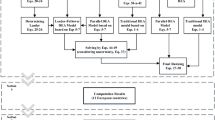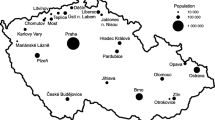Abstract
The paper demonstrates a relatively new perspective application of data envelopment analysis (DEA) in the optimization of urban public transport (UPT) systems. For this goal a special two-phase approach is used. The first phase consists of applying a special adjusted DEA model—input oriented hybrid model with non-controllable and bounded inputs with categorical decision making units under constant returns to scale—for evaluating efficiency of UPT lines and for obtaining recommendations for improving their efficiency. Based on the recommendations from the first phase, in the second phase a possible assignment of dispatched vehicles of inefficient UPT lines is proposed. The results of the conducted analysis offer suggestions to improve efficiency of the UPT so that the balance between supply and demand for transport services is maintained. The proposed method is applied to the UPT system in a Slovak city, Banská Bystrica.
Similar content being viewed by others
Notes
Note: Although the disposable vehicle fleet of the transport companies includes 6 vehicle types (see Table 3), in this case it is relevant to consider only 5 vehicle types since Karosa B732 and Karosa B932 have the same total transport capacity.
References
Agarwal S (2009) Measuring the efficiency of public transport sector in India: an application of data envelopment analysis. In: Proceedings of the conference in Philadelphia, USA. http://astro.temple.edu/banker/dea2009/paper/Agarwal.pdf
Arslan BG, Ergec EH (2010) The efficiency of participation and conventional banks in Turkey: using data envelopment analysis. Intl Res J Fin Econ 57:156–168
Asosheh A, Nalchigar S, Jamporazmey M (2010) Information technology project evaluation: an integrated data envelopment analysis and balanced scorecard approach. Expert Syst Appl 37:5931–5938
Banker RD, Charnes A, Cooper WW (1984) Some models for estimating technical scale inefficiencies in data envelopment analysis. Manag Sci 30(9):1078–1092
Barnum D T (2009) Bibliography of urban transit DEA publications. Soc Sci Res Netw. http://ssrn.com/abstract=1350583
Barnum DT, Tandon S, McNeil S (2008) Comparing the performance of bus routes after adjusting for the environment using data envelopment analysis. J Transp Eng 134(2):77–85
Barnum DT, Gleason JM (2008) Estimating data envelopment analysis frontiers for nonsubstitutable inputs and outputs: the case of urban mass transit. Working Paper of a Great Cities Institute GCP-08-03
Barnum DT, McNeil S, Hart J (2007) Comparing the efficiency of public transportation subunits using data envelopment analysis. J Public Transp 10(2):1–16
Charnes A, Cooper WW, Rhodes E (1978) Measuring the efficiency of decision making units. Eur J Oper Res 2(6):429–444
Charnes A, Cooper WW, Golany B, Seiford LM, Stutz J (1985) Foundations of data envelopment analysis for Pareto-Koopmans efficient empirical production functions. J Econ 30(12):91–127
Čiampor M, Kobza V, Matala M (2010) 60 rokov MHD v Banskej Bystrici (60 years of UPT in Banská Bystrica city). Martin Matala, Banská Bystrica
Cook WD, Green RH (2000) Project prioritization: a resource-constrained data envelopment analysis approach. Soc Econ Plan Sci 34:85–99
Cooper WW, Seiford LM, Tone K (2007) Data envelopment analysis: a comprehensive text with models, applications, references and DEA—solver software, 2nd edn. Springer Science and Business Media, Inc., New York
Dlouhý M, Jablonský J, Novosádová I (2007) Využití analýzy obalu dát pro hodnocení efektivnosti českých nemocnic. (Utilization of data envelopment analysis in the evaluation of Czech hospitals). Polit Ekon 1:60–71
Dohmen A, Leyer M (2010) Combining data envelopment analysis and business process simulation for analyzing the efficiency of business processes. Lect Notes Eng Comp 3:2134–2138
Eilat H, Golany B, Shtub A (2006) Constructing and evaluating balanced portfolios of R &D projects with interactions: a DEA based methodology. Eur J Oper Res 172:1018–1039
Emrouznejad A, Parker BR, Tavares G (2008) Evaluation of research in efficiency and productivity: a survey and analysis of the first 30 years of scholarly literature in DEA. Soc Econ Plan Sci 42(3):151–157
Farrell MJ (1957) The measurement of productive efficiency. J R Stat Soc Ser A-G 120(3):253–281
Frei F X, Harker P T (1996) Measuring the efficiency of service delivery processes: with application to retail banking. Soc Sci Res Netw. http://ssrn.com/abstract=7682
Jandaghi G, Matin HZ, Doremami M, Aghaziyarati M (2010) Efficiency evaluation of qom public and private hospitals using data envelopment analysis. Eur J Econ Fin Adm Sci 22:83–92
Johnes J, Yu L (2008) Measuring the research performance of Chinese higher education institutions using data envelopment analysis. China Econ Rev 19(4):679–696
Karlaftis MG (2004) A DEA approach for evaluating the efficiency and effectiveness of urban transit systems. Eur J Oper Res 152:154–164
Ku-Mahamud KR, Kasim MM, Ghani NFA, Abdullah F (2011) An efficiency analysis of projects using DEA. Eur J Sci Res 52(4):476–486
Lin CH, Lee CH, Chen ZJ (2010) An expert system approach to medical region selection for a new hospital using data envelopment analysis. iBusiness 2(2):128–138. doi:10.4236/ib.2010.22016
McMillan ML, Datta D (1998) The relative efficiencies of canadian universities: a DEA perspective. Can Public Policy 24(4):485–511
Ozbek ME, Garza JM, Triantis K (2009) Data envelopment analysis as a decision-making tool for transportation professionals. J Transp Eng Asce 135(11):822–831
Sampaio BR, Neto OL, Sampaio Y (2008) Efficiency analysis of public transport systems: lessons for institutional planning. Transp Res A Policy 42(3):445–454
Sufian F (2010) Modelling banking sector efficiency: a DEA and time series approach. Ekonomika 89(2):111–119
Surovec P (2007) Hromadná osobná doprava. (Urban public transport). University of Žilina, Žilina
Suzuki S, Nijkamp P, Rietveld P, Pels E (2010) A distance friction minimization approach in data envelopment analysis: a comparative study on airport efficiency. Eur J Oper Res 207(2):1104–1115
Talluri S (2000) A benchmarking method for business-process reengineering and improvement. Int J Flex Manuf Sys 12:291–304
Tavares G (2002) A bibliography of DEA (1978–2001), RRR 01–2002, RUTCOT-Rutgers Centre for OR. Rutgers University, New Jersey
Tone K (2001) A slacks-based measure of efficiency in data envelopment analysis. Eur J Oper Res 130: 498–509
Transport Research Institute (2008a) Vypracovanie plánu dopravnej obslužnosti mesta Banská Bystrica. (Transport Service Plan of Banská Bystrica City). http://www.banskabystrica.sk/download_file_f.php?id=58015
Transport Research Institute (2008b) Vypracovanie plánu dopravnej obslužnosti mesta Banská Bystrica, Ekonomické vyhodnotenie navrhovaného systému MHD s dopadom na finančné ukazovatele. (Transport Service Plan of Banská Bystrica City. Economic evaluation of impact of the proposed UPT system on financial indicators). http://www.banskabystrica.sk/download_file_f.php?id=58017
Zhou Y, Chen Y (2010) The analytic supporting tools for business reengineering with system integration design. IEEE Trans Syst Man Cybern A 40(2):285–300
Author information
Authors and Affiliations
Corresponding author
Rights and permissions
About this article
Cite this article
Roháčová, V. A DEA based approach for optimization of urban public transport system. Cent Eur J Oper Res 23, 215–233 (2015). https://doi.org/10.1007/s10100-013-0314-7
Published:
Issue Date:
DOI: https://doi.org/10.1007/s10100-013-0314-7




